WHAT YOU SEE SHAPES WHAT YOU’LL GET
The red dot sight dominates the American rifle market. It is impossible to know how many red dot-equipped carbines ride along in police cars, are carried by soldiers on patrol in faraway lands, and bust clay pigeons and ring steel at shooting ranges every weekend across the USA. Red dots are so popular that it is possible they outnumber all other scope types combined, at least on modern semi-automatic and military rifles. But the red dot isn’t perfect, and it isn’t the best optic for every shooter. The red dot plus magnifier combo battled the low power variable optic in this Scope University article, and now it must defend itself again. A new class of compact, lightweight 1x prism scopes are coming hard to knock the red dot off its throne. The Trijicon mini-ACOG, an old workhorse, has been rediscovered and is enjoying a surge in popularity as well. Should you stick with proven red dot technology, or switch to one of the upstart micro prism scopes? We are going to break it down for you, so sit up straight and pay attention–class is in session!
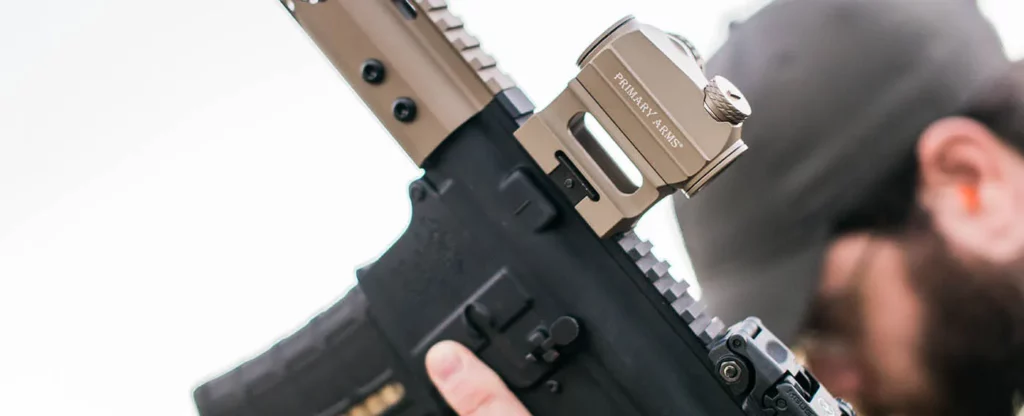
HAIL TO THE KING – RED DOT SIGHTS
For the past 25 years the red dot sight (or reflex sight) has been the king of close quarters battle (CQB) type shooting. The technology involved has improved drastically over that time, but the optical theory is roughly the same as reflector gunsights used in fighter planes all the way back in World War II. A reticle created by reflected light located at the focus point of a lens appears to be placed steadily in front of the viewer’s eye, focused at an infinite distance. You can move your eye around a large area behind one of these sights while still seeing the reticle. If you can see the reticle anywhere through the sight’s window at all, superimposing it on top of your target will result in a hit with reasonable accuracy. Due to parallax error, at close range inside 25 yards it is technically better to keep the reticle centered in the middle of the red dot’s field of view. However, that close range also minimizes the impact of the parallax error—what might cause a completely missed target at 500 yards won’t even be noticeable at 25 yards.
The red dot sight’s biggest advantages are simplicity and speed of sight acquisition. The bright red (or sometimes green) dot reticle provides great contrast against the target and field of view in almost any lighting conditions, night or day. Manually adjustable brightness levels quickly fine-tune the reticle to suit the shooter’s personal preference. Because there is no magnification, red dot shooting is done with both eyes open and focused on the target itself. This arrangement is the fastest sight picture ever devised by modern science for aiming—whether the firearm is a .22 LR rifle out on the farm or the cannon in a F-22 fighter jet. The speed advantage continues to make a difference even after your shot flies down range. Placing a red dot sight on a high recoiling rifle allows for extremely fast sight re-acquisition as you bring the gun back into alignment after each shot. Mounted on self-loading firearms that exhibit little felt recoil, the red dot sight allows constant sight tracking as multiple rounds may be fired without losing the sight picture at all.
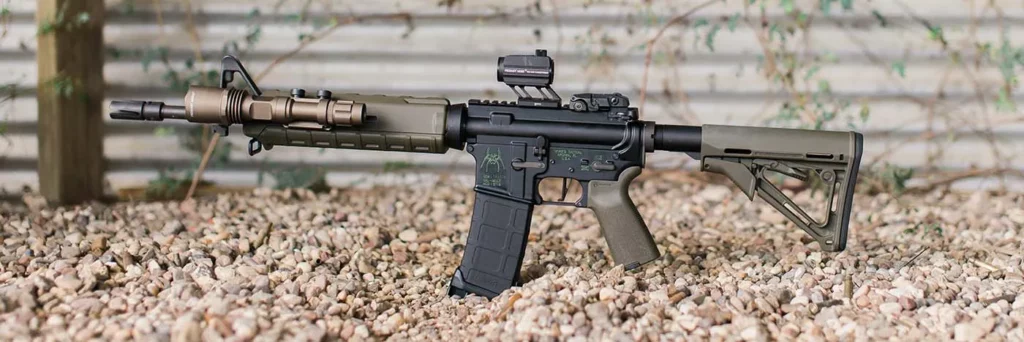
The simplicity of the red dot sight is also hard to beat. Military testing and experience has proven that new shooters find it much easier to learn basic marksmanship skills with red dots than with physical “iron sights”. Iron sight shooting requires aligning three points—the rear sight, front sight, and target—and disciplining yourself to focus on the front sight even though this will blur the target. The red dot sight allows the shooter to instinctively focus on the target itself, yet still gain both speed and accuracy compared to iron sight shooting.
Some red dot sights feature optional illumination settings so low they cannot be seen by the naked eye at all. At these settings the reticle is intended to be amplified by a separate night vision optic looking through the red dot scope. Traditionally the night vision unit is mounted on the rifle behind the red dot, but due to the red dot’s excellent optical flexibility it is also possible to use it with a night vision monocular mounted on the shooter’s head. A less exotic, but much more common option is to mount a 3x or even 6x magnifier behind the red dot, which magnifies the entire field of view including the dot itself. Magnifiers help extend the effective range of the red dot sight beyond what is possible with any 1x magnification scope, but they come with their own set of complications and disadvantages. You can read more about the red dot plus magnifier optics combination by clicking here.
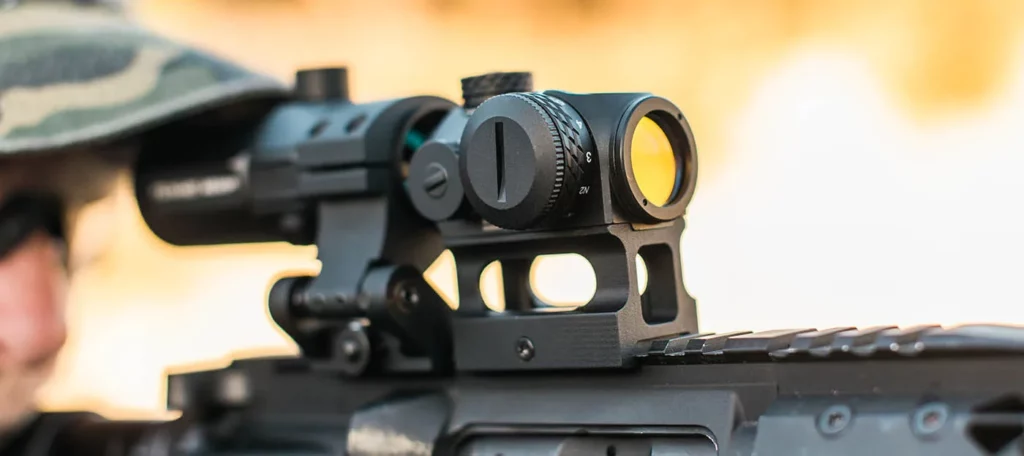
The red dot sight does have some drawbacks. While battery life for modern red dots is so good that they can be left on a medium setting for years at a time, if the battery does fail the reflected reticle image will disappear entirely, rendering the scope unusable. For this reason, many shooters prefer to employ back up iron sights that look through the red dot’s window in an arrangement called co-witness. Looking down the rifle at the target with flip-up iron sights deployed, the red dot will appear superimposed at the tip of the front sight, giving a confirmation that both sighting systems are on target. While you could shoot this way all the time (in the days of fixed front sights there was no choice), it’s now more common for shooters to fold their iron sights out of the way and use only the red dot, saving the back-up sights for emergency use only. If the red dot aligns with the sights in the centerline of the red dot scope’s window, the arrangement is called an “absolute co-witness.” Using a taller mount to shift the red dot scope further away from the rail moves the position of the dot lower in the window when viewed through the iron sights. This arrangement is called a “lower 1/3rd co-witness” and is useful when the iron sights are fixed, when the shooter has a larger head or otherwise enjoys shooting with an optic mounted just a bit higher up.
The vast majority of reflex sights use a simple round dot as the point of aim—thus the term “red dot sight”. Smaller dots provide greater accuracy but are not as fast to acquire as larger dots. In this arrangement, the center point of aim is the only information being presented to the user. EOTech sights feature reticles using a very small 1 MOA center dot surrounded by a ring measuring 68 MOA in diameter. The ring is used for very fast sight acquisition at close range, with the center dot used for precision when time allows. Some red dots, such as the Holosun HS503G-ACSS, feature advanced reticles that can be used to compensate for bullet drop. The ACSS Holosun features a center chevron that attracts the eye quickly yet provides an infinitely small aiming point at the tip which never obscures the target like a superimposed dot does. Small dots underneath act as bullet compensation holdovers, and a quick-acquisition horse shoe can be activated or deactivated by the user. See an example below.
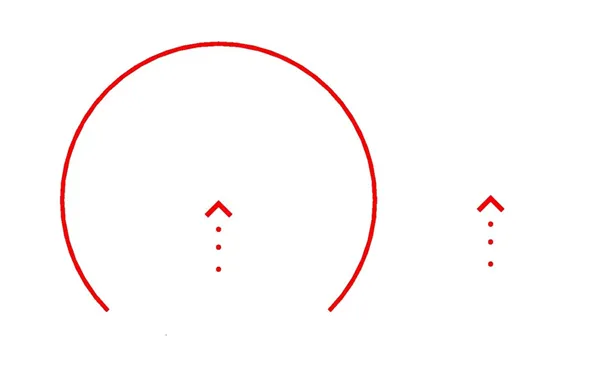
Some shooters with astigmatism or other eye issues have difficulty perceiving the reflected light from a red dot scope. Instead of a simple round dot, they see a comet, or a star, making aiming with precision difficult or impossible. Increased reticle complexity only makes matters worse. Sometimes this situation can be helped by using a holographic weapons sight. This technology differs from a standard red dot because the reticle is imprinted on a holographic film mounted on glass, which is then illuminated by a laser diode. EOTech is the most well established holographic weapons sight manufacturer, but Vortex Optics recently released their Razor AMG UH-1 holographic sight. The reticles presented by these optics sometimes appear sharper than standard LED red dots, but some shooters’ eyes see the holographic sight reticles as annoyingly “grainy” and prefer traditional red dots. The only true way to learn which technology suits your eye is to physically look through both types of reflex sight and choose the type that you like best.
Buy A Red Dot Sight When:
- You want the fastest sight picture modern technology can deliver
- Your eyes perceive red dot reticles clearly, without issues
- You demand extremely bright reticle illumination
- You don’t require an etched reticle
- You want maximum battery life
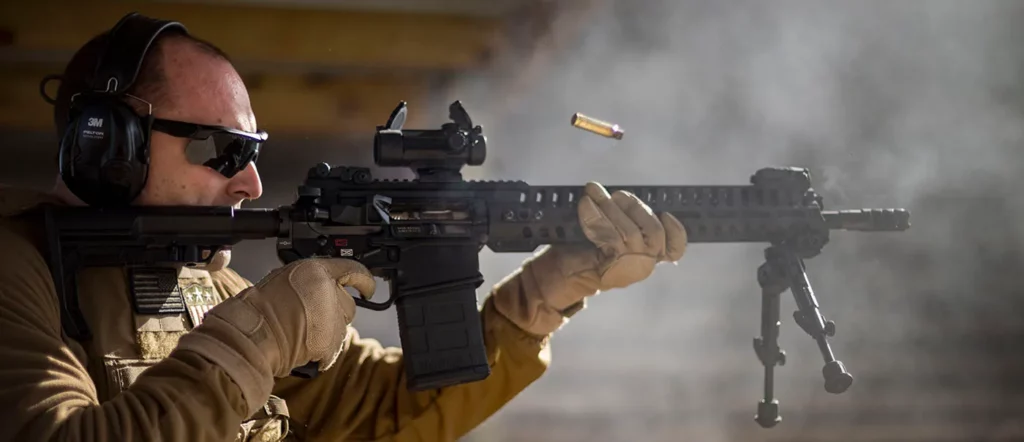
A CHALLENGER APPEARS – 1X PRISM SCOPES
Like reflex sights, prism scopes have been around for a long time and are well proven. Rifle scopes featuring prism erector systems existed before World War 1 and have been steadily improved since, usually featuring low amounts of fixed magnification. Much more recently, brands like Burris, Vortex, Primary Arms, and Bushnell have released 1x prism scopes intended to directly address the weaknesses of the red dot scopes and compete directly against them.
The primary difference is the use of a chemical or laser etched reticle in the 1x prism scope. Although they can be illuminated through multiple brightness settings like a red dot, with illumination set to “off”, a missing battery, or even a broken illumination system the reticle will not disappear entirely from the field of view. The black outline of the etched reticle remains and is always ready to use, although this becomes more difficult in low light situations like dawn and dusk.
The etched reticle offers multiple advantages over reflected light reticles. When combined with an adjustable ocular ring (sometimes called a diopter or fast-focus eyepiece), the etched reticle presents a sharp, crisp sight picture even when the user’s eyes have astigmatism. Even with perfectly healthy eyes, the etched reticle design is sharper than an equivalent red dot reticle. The etched reticle can be made more complex than the most advanced red dot reticles. For example, the Primary Arms ACSS Cyclops reticle provides the user with critical information like target range estimation and bullet drop compensation holdovers.
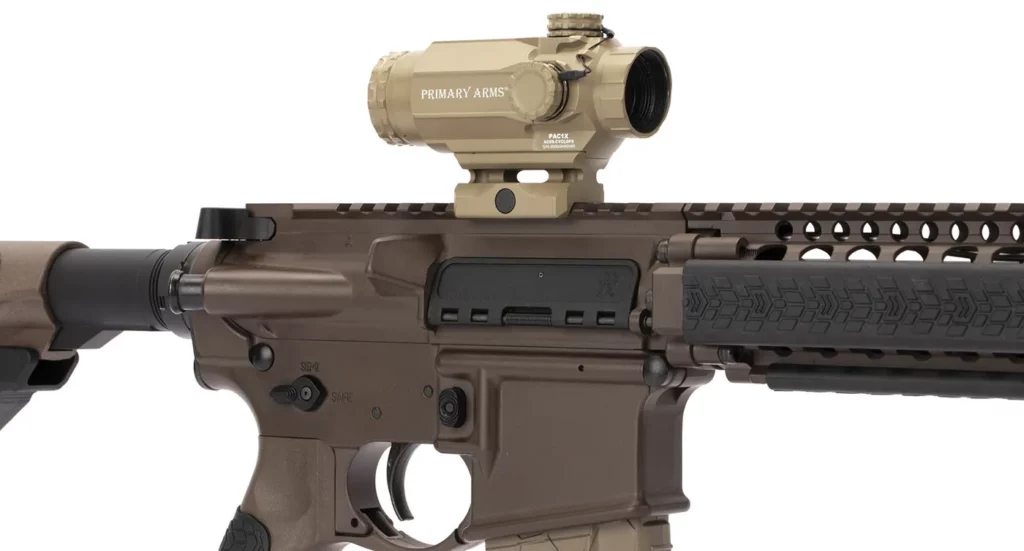
Unlike red dot scopes, 1x prism scopes have a distinct “eye box” area. Imagine the eye box as a three-dimensional blob of space located behind the scope. The shooter’s eye needs to be somewhere inside that blob to get a sight picture through the prism scope. Because the eye box area is more restrictive than the entire field of view available in a red dot sight, 1x prism scopes will be just slightly slower to acquire than red dots, if all else is equal. With some practice and a properly set up optic, the speed difference at close quarters distances can be minimized, especially if you can get a fast, consistent “cheek weld” on your rifle’s stock. A stock with a good cheek weld allows you to quickly put your eye in close to the same place behind the scope repeatedly with good consistency. If your firearm is an AR-15 pistol build, an AK-47 with underfolding stock, or another configuration with a poor or nonexistent cheek weld, the 1x prism scope will lose much more speed compared to the red dot.
1x prism scopes lose the night vision compatibility some red dots offer and adding a 3x magnifier to one is sketchy. Magnifiers are intended to work with red dot sights, which have their reticles focused at infinity. By adjusting the ocular rings on both the magnifier and the prism scope, it may be possible to create a usable combination for keeping both the reticle and target area in focus– at certain distances at least. However, moving the magnifier out of the way requires adjusting the prism scope’s ocular ring again for use by the naked eye alone. The 3x magnifier is much easier to use with a red dot than with a prism scope.

Current 1x prism scopes also do not feature night vision compatibility. With illumination off, night vision devices have difficulty creating enough contrast with the black etched reticle to be useful. But even the lowest illumination settings are too bright and will damage the night vision scope as it intensifies the reticle’s red light.
Buy A 1X Prism Scope When:
- You have astigmatism or eye issues that hurt red dot performance for you
- You want intelligent reticle features like ranging and BDC
- You want a black, etched reticle for certain shooting situations or in case of battery failure
- You don’t require retina-burning reticle brightness
- You don’t mind swapping batteries more often
WHATS OLD IS NEW AGAIN – TA44 MINI ACOGS
The most famous prism scopes are the Trijicon Advanced Combat Optical Gunsights. The full size ACOG’s widespread use by the US military during the War on Terror in Iraq, Afghanistan, and around the world makes it instantly recognizable. Trijicon also makes a series of much smaller “mini ACOGs”. While these scopes have more than a decade of proven performance behind them, they are being re-discovered now as shooters appreciate their unique features and abilities.
The Trijicon TA44 prism scopes are incredibly small and light, measuring about four inches long and weighing in at only 5.1 ounces. Despite their tiny size, the share the full size ACOG’s unequaled reputation for “bomb proof” toughness. With incredible glass quality that must be seen to be appreciated and a very forgiving eye box, the TA44 features sight acquisition speed rivaling any scope on the market.
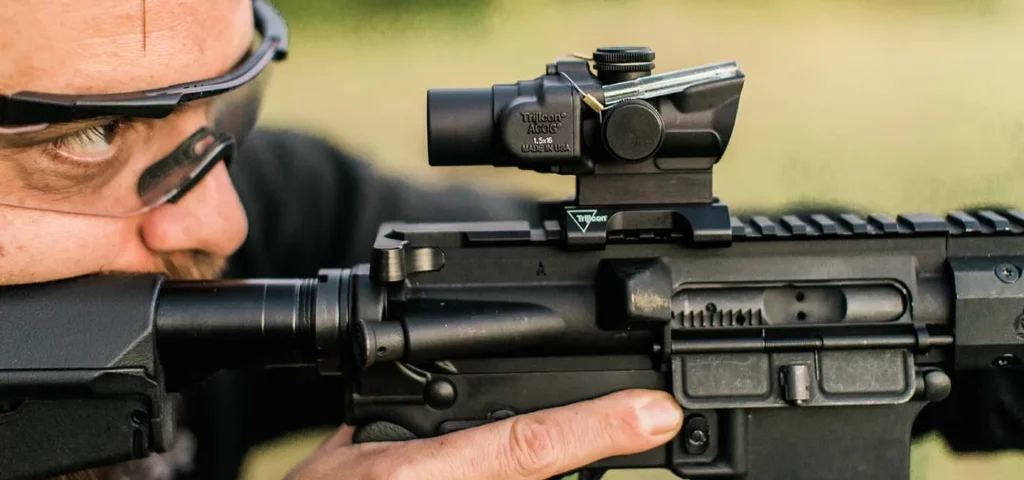
The speed of the TA44 mini-ACOG is more remarkable because it is not a true 1x magnification scope, but a 1.5x scope, and only has a 16mm objective lens. Shooting this scope with both eyes open makes use of the Bindon Aiming Concept, developed by Trijicon’s founder Glyn Bindon. Despite the slight magnification, when looking through the scope and keeping both eyes open, the human brain merges everything together, creating a very quick sight picture that also shows the target in tremendous detail. Key to the Bindon Aiming Concept is a very bright reticle, powered by a light-gathering fiber optic line laid along the top of the scope during the day and tritium at night. Therefore, the TA44 requires no batteries for day or night use.
Original TA44 models featured simple “dot inside ring” reticles similar in concept to the EOTech holographic weapon sights. As their popularity increased, Trijicon and Primary Arms partnered to produce the TA44-ACSS scopes incorporating the Advanced Combined Sighting System with either green or red illumination. These scopes provide AR-15 and AK-47 shooters with the mini-ACOG’s excellent optical characteristics combined with ACSS target ranging and bullet drop compensation (to 500 yards with 5.56 NATO or 400 yards with 7.62×39).
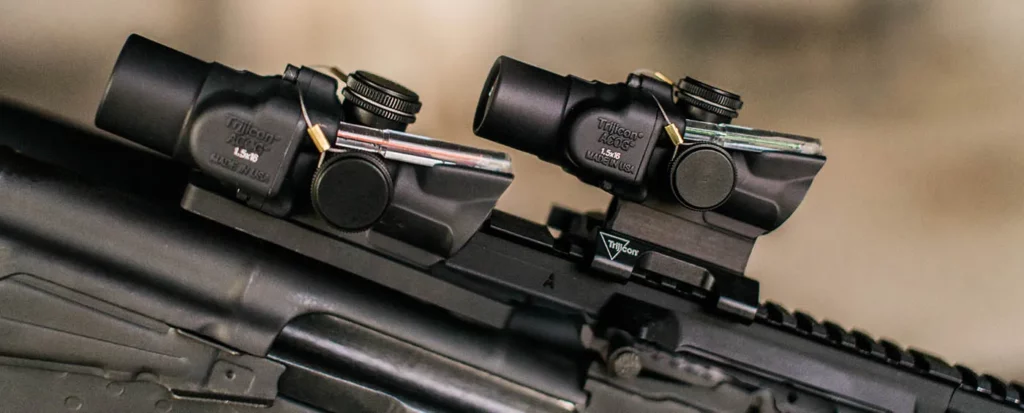
Life looks better through an ACOG — for most shooters at least. However, the TA44 lacks an adjustable ocular so if your eyes can’t focus on its reticle, you are simply out of luck. Many shooters find a 500 yard BDC to be optimistic for any 1.5x optic, even one with amazing glass. Some shooters don’t care for the 1.5x magnification and can’t get the Bindon Aiming Concept to work for them. There is no magnifier capability with the TA44, nor night vision compatibility. But the largest barrier to ACOG ownership for most shooters is the price of admission—its $899 price tag is higher than either the red dot or 1x prism scope options.
Buy A 1.5X TA44 ACOG with ACSS Reticle When:
- The Bindon Aiming Concept works well for you
- You want very bright reticle illumination but hate the idea of batteries entirely
- You want amazing glass quality in a tiny, lightweight package
- In case of nuclear war, survivors should include radioactive roaches, bottle caps, and your rifle scope
- You can pay extra for all of the above
EYE OF THE BEHOLDER
Which close quarters sight is best for you depends greatly on how your eye perceives their sight pictures. If you have good eyesight and see red dot sights clearly, their excellent flexibility, value, and ultimate speed up close make them hard to beat. If your firearm is configured without a stock or doesn’t allow for a repeatable cheekweld, the red dot will be the fastest sight available bar none. Finally, if you might decide to run a magnifier or night vision unit behind your 1x optic, the red dot is clearly the best choice. However, if you have astigmatism or your eyes otherwise don’t “like” the red dot’s sight picture, the 1x prism scopes or TA44 ACOGs are an excellent alternative. Some shooters can’t get used to shooting at 1.5x magnification with both eyes open—if the Bindon Aiming Concept isn’t for you, then you should look for a true 1x prism scope. Some folks will just have to decide if the glass clarity and features of the Mini-ACOG are worth the big price increase over the red dot or 1x prism scopes.
Because the right close quarters scope for you is so dependent on your eyes, the best way to decide between these scopes is to look through each type and, if possible, “try before you buy”—firing some live rounds down range. While you can get a pretty good idea from reading articles and watching review videos, choosing your optic without looking through one first is like buying a three piece suit online—it may have the look and features you want, but you have to hope it will actually fit you well.
If you have any questions about the red dots, 1x prism scopes, or Trijicon ACOGs carried at Primary Arms, feel free to email info@primaryarms.com or call 713-344-9600. Our dedicated customer service team here in Houston, Texas is standing by to help.



